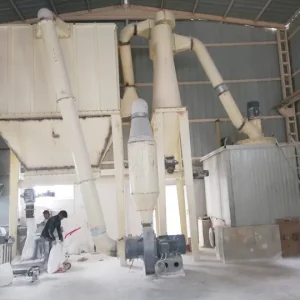كربونات الكالسيوم مركب معدني يستخدم على نطاق واسع وله تطبيقات صناعية مختلفة. ولتلبية الطلب على كربونات الكالسيوم المطحونة بدقة، تم تطوير تقنيات طحن متقدمة. ومن بين هذه التقنيات مطحنة الأسطوانة العمودية لكربونات الكالسيوم. تقدم هذه المقالة استكشافًا متعمقًا لمطحنة الأسطوانة العمودية لكربونات الكالسيوم، ومناقشة تعريفها ومبادئ تشغيلها ومزاياها وعيوبها.
التعريف ومبادئ التشغيل:
مطحنة الأسطوانة العمودية لكربونات الكالسيوم هي معدات متخصصة مصممة لطحن ومعالجة كربونات الكالسيوم إلى مسحوق ناعم. وهي تتكون من نظام أسطوانة عمودية تدور حول محورها، مما يتيح طحنًا فعالًا ودقيقًا للمادة. يتم تغذية مادة تغذية كربونات الكالسيوم من خلال مدخل مركزي، وتقوم القوة الطاردة المركزية الناتجة عن الأسطوانات الدوارة بطحن المادة على طاولة الطحن أو المسار. ونتيجة لذلك، يتم طحن جزيئات كربونات الكالسيوم بشكل ناعم وتصنيفها لتحقيق توزيع حجم الجسيمات المطلوب.
مميزات مطاحن الأسطوانة العمودية لكربونات الكالسيوم:
- كفاءة طحن عالية: تستخدم مطاحن الأسطوانات الرأسية مزيجًا من قوى الضغط والقص لطحن جزيئات كربونات الكالسيوم بكفاءة. تتم عملية الطحن في مساحة محصورة، مما يضمن الطحن الشامل ويقلل من استهلاك الطاقة.
- التحكم المعزز في حجم الجسيمات: توفر مطاحن الأسطوانة الرأسية تحكمًا ممتازًا في توزيع حجم جسيمات كربونات الكالسيوم المطحونة. تتيح سرعة الدوار القابلة للتعديل وضغط الطحن وإعدادات التصنيف التحكم الدقيق وتخصيص حجم جسيمات المنتج النهائي.
- مجموعة واسعة من التطبيقات: يمكن لمطاحن الأسطوانة العمودية لكربونات الكالسيوم التعامل مع أنواع مختلفة من كربونات الكالسيوم، بما في ذلك الأشكال الطبيعية والاصطناعية. وهي مناسبة لطحن المواد بمستويات مختلفة من الصلابة ومحتوى الرطوبة والتآكل.
- متطلبات صيانة أقل: تتميز مطاحن الأسطوانة الرأسية بتصميم بسيط نسبيًا وأجزاء متحركة أقل مقارنة بمطاحن الطحن التقليدية. ويؤدي هذا إلى تقليل احتياجات الصيانة ووقت التوقف عن العمل وتقليل التكاليف المرتبطة بذلك.
- تصميم موفر للمساحة: تتميز مطاحن الأسطوانة العمودية عادةً بحجمها الصغير، مما يجعلها مناسبة للتركيبات ذات المساحة المحدودة. ويمكن دمجها بسهولة في خطوط الإنتاج الحالية أو استخدامها كوحدات مستقلة.
عيوب مطاحن الأسطوانة العمودية لكربونات الكالسيوم:
- تكلفة الاستثمار الأولية: تكلفة الاستثمار الأولية لطاحونة الأسطوانة العمودية لكربونات الكالسيوم أعلى نسبيًا مقارنة بمعدات الطحن الأخرى. ومع ذلك، فإن الفوائد طويلة الأجل وتوفير التكاليف التي يتم تحقيقها من خلال تحسين الكفاءة وتقليل الصيانة يمكن أن تعوض هذا الاستثمار الأولي.
- قدرة محدودة على طحن المواد الخشنة: تم تصميم مطاحن الأسطوانات الرأسية في المقام الأول لتطبيقات الطحن الدقيق والدقيق للغاية. قد تكون لها قيود في طحن الجسيمات الخشنة بكفاءة بسبب طبيعة مبادئ التشغيل وخصائص التصميم الخاصة بها. قد تكون هناك حاجة إلى خطوات إضافية لتقليل الحجم أو معدات بديلة لمعالجة الجسيمات الكبيرة.
- الحساسية لخصائص المواد: يمكن أن تؤثر خصائص مواد معينة، مثل الصلابة ومحتوى الرطوبة والتآكل، على أداء مطاحن الأسطوانة العمودية لكربونات الكالسيوم. قد تكون المعلمات التشغيلية والتعديلات المثلى ضرورية لتحقيق نتائج الطحن المرغوبة لمواد معينة.
- احتمالية التحميل الزائد للنظام: في الحالات التي تحتوي فيها مادة التغذية على شوائب أو جزيئات صلبة، هناك خطر التحميل الزائد لنظام مطحنة الأسطوانة الرأسية. يمكن أن يؤدي هذا إلى انخفاض كفاءة الطحن وزيادة التآكل والتلف في المعدات وانقطاعات محتملة في الإنتاج.
توفر مطحنة الأسطوانة العمودية لكربونات الكالسيوم العديد من المزايا، بما في ذلك كفاءة الطحن العالية، والتحكم المحسن في حجم الجسيمات، ونطاق التطبيق الواسع، ومتطلبات الصيانة المنخفضة، والتصميم الموفر للمساحة. ومع ذلك، من المهم مراعاة تكلفة الاستثمار الأولية، وقدرة الطحن الخشن المحدودة، والحساسية لخصائص المواد، وإمكانية زيادة تحميل النظام. يساعد فهم هذه المزايا والعيوب في تقييم مدى ملاءمة مطحنة الأسطوانة العمودية لكربونات الكالسيوم وجدواها الاقتصادية لتطبيقات الطحن المحددة.


